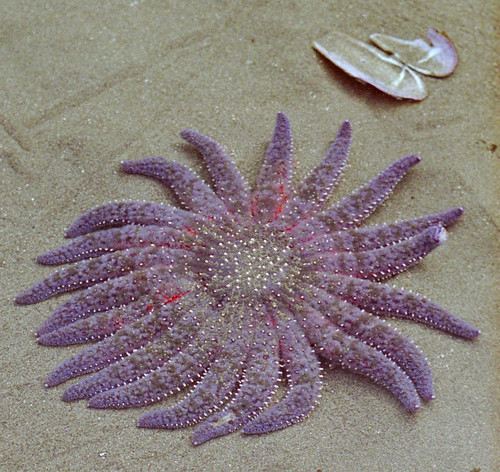A sunflower star waits for the tide onthe beach at South Cove at Cape Arago on the Oregon Coast. I should have spent more time with this star, but I was on my way back up to the trail. I am fascinated by the sand tracks the star made when it the tide went out under it. These creatures came move fairly fast for a sea star, but this one was too far from solid rock to make any headway. Hopefully the tide returned before the birds got to it.
SLIDE
martes, 22 de septiembre de 2009
21 Arms at Quillayute Needles
21 Armed Sunflower Starfish at Quillayute Needles. Olympic National Park.
21 Arms at Quillayute Needles
Sunflower starfish
Taken at the Seattle Aquarium
The sunflower sea star (Pycnopodia helianthoides) is a large predatory sea star usually with 16-24 limbs called rays. It is the largest sea star in the world. Sunflower sea stars can grow to have an arm span of 1 m (3 ft.) in diameter.[1] The color of the sunflower sea star ranges from bright orange, yellow and red to brown and sometimes to purple, with soft, velvet-textured bodies and 16-24 arms with powerful suckers. Most sea star species have a mesh-like skeleton that protects their internal organs. Easily stressed by predators such as large fish and other sea stars, they can shed arms to escape, which will grow back within a few weeks. They are part of the diet of the king crab.
The sunflower sea stars are quick, efficient hunters, moving at a speed of one meter per minute, using 15,000 tube feet which lie on the undersides of the body. They commonly hang around urchin barrens, as the sea urchin is a favorite food. They also eat clams, snails, abalone, sea cucumbers and other sea stars. In Monterey Bay, California, they will feed upon dead or dying squid. Although the sunflower sea star can greatly extend its mouth, for larger prey, the stomach can extend outside the mouth to digest prey, such as gastropods like abalone. Their feeding behavior was filmed in the 2006 BBC nature documentary, Planet Earth.
http://en.wikipedia.org/wiki/Sunflower_starfish
Sunflower starfish







